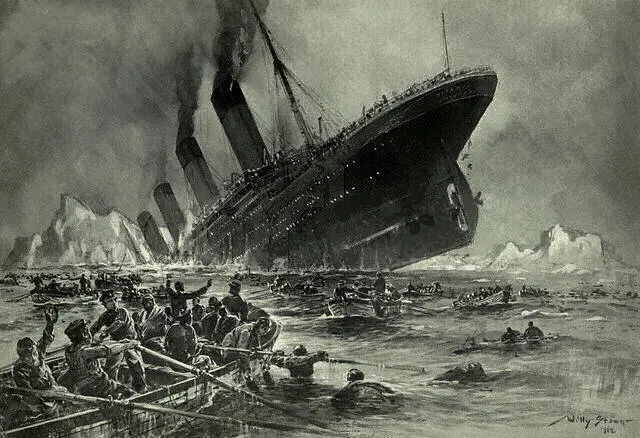In 1898, a novella was written by author Morgan Robertson that was eerily similar to a famous event that would happen 14 years later — the sinking of the Titanic. Did the author have some type of clairvoyance into what would happen to the ship, or was it just an amazing feat of coincidence?
The novella Robertson wrote, called “Futility,” was about an unsinkable ship called the Titan. The ship in his book crashes into an iceberg and sinks in the North Atlantic. Here are the similarities between Robertson’s book and the real sinking of the Titanic.
The Titan, the ship described in the book, was the largest of its kind and the largest of the day, the same as the Titanic. You can also observe that the name Titan is only missing the final two letters to make it into the Titanic–the “i” and “c.”
Both of the ships were described as unsinkable, and each hit an iceberg and sunk in mid-April.
Both ships were very close in size. The Titanic only measured 25 meters longer.
Even though each had a capacity of 3,000 passengers, both only carried the minimum number of lifeboats to be deemed legal. Titan had 24 lifeboats, while the Titanic had 20 lifeboats. The Titan was carrying its full capacity of passengers of 3,000, while the Titanic had 2,228.
Both ships had three propellers and two masts, and Titan had 19 watertight compartments to the Titanic’s 16. Both were British-made and made of steel.
The speed of impact for the Titan into the iceberg was 25 knots, while the Titanic struck at 22.5 knots. The time of impact for the Titan was about midnight, and the Titanic struck the iceberg at 11:40 PM. The point of impact for both ships was starboard, and both ships had their disasters in April.
The biggest discrepancy between the events of the fictional Titan, and the real Titanic, was the number of survivors. Titan had only 13 survivors, while Titanic had 705 survivors.
There are other discrepancies, however. The Titan was actually traveling from the United States to England, while the Titanic was going the other direction. But even this is similar in a way.
Did Robertson somehow have a premonition into what would be the fate of a ship 14 years later, or was this just good writing about a subject the author knew a lot about? Most likely, it is the latter.
Robertson wrote about maritime activities and was an experienced seaman. He realized that ships were getting larger and larger and that the possibility of a catastrophe was imminent. Robertson even dismissed claims that he was somehow clairvoyant and simply said that he knew what he was writing about.
But Robertson may have believed he was somehow psychic. A series of essays about his life called Morgan Robertson, the Man, which were accounts from his acquaintances, said he did believe some spirit was using him to write some of his works about future events. Still, one can’t overlook the fact that Robertson did have a keen sense of shipbuilding and the current trends, along with the knowledge about the hazards of the sea. Unfortunately, his prediction turned out to be true.
“Futility” wasn’t a popular book in its time and even went out of publication before the Titanic was designed. It wasn’t until the Titanic disaster that people even began to notice his book. It was reissued after the Titanic disaster and given the name Wreck of the Titan. Some changes were made to the speed and power of the Titan that made it surpass the Titanic. Robertson never saw any profits from the fame he got from writing “Futility.” He died in 1915 from an overdose of protiodide, a mercury iodide drug.
Even with Robertson’s knowledge of the sea and ships, and whether he truly believed he was clairvoyant or not, it is uncanny the similarities he described in his book with what would be the fate of the Titanic.
One More Bonus Titanic Fact
The lunch menu on the final day of the Titanic was sold at auction for $88,000 on September 30, 2015. The menu was saved by a first-class passenger who took it aboard a lifeboat when the ship sank in 1912.
The passenger who had the menu was Abraham Lincoln Salomon, and he boarded Lifeboat 1, which was also known as the “Millionaire’s Boat” or “Money Boat” since it was filled with first-class passengers. That lifeboat was said to have been rowed away instead of rescuing more people. It was rumored that the crew had been bribed to do so by Lucy Duff-Gordon and Lord Cosmo Duff-Gordon. They were later cleared from wrongdoing in an inquiry by the British Wreck Commission. There were only six people in Lifeboat 1 when it pulled away from the Titanic.
The lunch menu had such things as Grilled Mutton Chops, Fillets of Brill, and Chicken a la Maryland. It also listed a buffet consisting of Potted Shrimp, Norwegian Anchovies, Salmon Mayonnaise, and many other things. In addition to the menu, Salomon took with him a ticket from the Titanic’s Turkish baths. It had the names of three other people that were in the lifeboat with him.
Sources:Time, IO9, History on the Net


